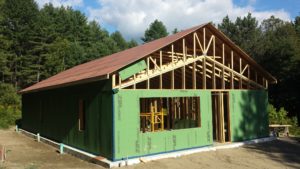By Barbara and Gregory Whitchurch
Over the years, Green Energy Times has run quite a few articles about Passive House, so it’s likely you’ve seen the term. (Don’t confuse it with “passive solar,” which is just one aspect of Passive House). So what exactly is it, and why would anyone go to the trouble of building one? It’s expensive, complicated, hard to finance, and hard to find a qualified builder, right?
Wrong on all counts. Building a Passive House (PH) is no more expensive these days than building a conventional home. Many builders and architects in Vermont are certified in PH; the specialized building materials are easily available; and lending institutions are offering interest breaks for both new construction and renovations.
The main advantages:
PH saves energy, up to 90% of the energy demands of a conventional building.
The Residential Building Energy Code (RBES) is the baseline here in Vermont. Energy Star 3.0 from the Department of Energy is 30% more efficient than RBES; the Building America code of Department of Energy is 45% more efficient than RBES.
The PH standard is 90% more efficient than RBES. These homes can reduce an annual $3,000 energy bill (LP, oil, electric, wood) to about $300! Since the entire home can run on electricity, a small solar array can offset one’s total energy use.

Habitat PH under construction. Page 29: Habitat PH in E. Montpelier, VT. Courtesy images: Chris Miksic
PH is more healthful and more comfortable. Because a PH is super-insulated, meticulously sealed to prevent heat loss, and uses high-performance windows and doors, there is very little air leakage. Instead, air exchange is done mechanically through a ventilation system, producing fresh air which is pollen- and dust-free, and controlling moisture, CO2 and VOCs (from cooking, painting, etc.). This freshness is noticeable when you enter a PH; the occupants often report decreased allergies, fewer colds, and better sleep. The temperature is also uniform from room to room — no cold spots, drafts, or steamy upstairs bedrooms. (And no more ladybugs, earwigs, ants or mice.)
PH is easier to maintain. Over the past few decades builders have moved from 2X4 to 2X10 construction. Now modern building science has moved on to super-insulated enclosures which find the “sweet spot” where no furnace or boiler is needed. Highly efficient heat pumps heat and cool these buildings. All the money saved on equipment and repairs goes toward producing even more energy savings for the occupants.
Four years ago we set about building a PH attached to our own “hippie home” – as an alternative to assisted living for Greg’s parents (http://bit.ly/PH-Cottage). Everyone involved in the project was new to PH, but even so, for about $173/ft2 we created a basement and two stories of timber-framed, extremely comfortable, ADA-compliant living space. The air is fresh; an induction cooktop makes cooking safer and more efficient; the entire house runs on electricity produced by the solar array on our home. Triple-pane Intus windows contribute to the coziness and quiet. In pursuit of our proof-of-concept demonstration, we also placed relative humidity, moisture and temperature sensors throughout the walls and roof; engineers, architects and builders are watching these readings as they demonstrate the superior safety and resiliency of this building.
Central VT Habitat for Humanity Chapter (http://bit.ly/VT-HfH) is finishing a PH in East Montpelier for a young couple and their young daughter. Its cathedral-ceilinged living room opens between huge windows to a protected deck. Window awnings allow winter solar gain while shielding the summer sun for cooling. Although small of footprint, the layout exudes spaciousness and openness. Continuously filtered, fresh air is provided by heat pump ventilator. A small 7kW PV array will offset the energy needs of the family.
It’s certainly not unusual to run across builders and remodelers who are still living in the last century. A lot of them will say things like, “A house has got to breathe!” — an excuse for sloppily allowing air leaks, the number one cause of lost heat, drafts and high heating bills. Or, “All that extra insulation will never pay off!” — an excuse for not keeping up with the evolving science of high-performance building. Widely available energy modeling software, such as the PH Planning Package (PHPP) and WUFI Passive, now exposes these excuses for what they are. A PH is not only the house of the future — it’s the house of the present.
For more information: www.PHAUSVT.org.











Leave a Reply